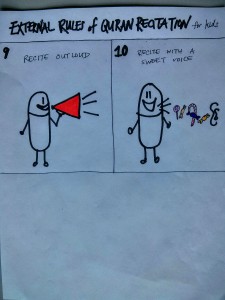Islamic Mosque Décor

For this post, I chose to focus on the theme of arts in mosques discussed in week 6. I chose to color in a design I found on online that resembled what I thought could be considered Islamic art from Frishmann and Khan’s, The Mosque, and the film, Islamic Art: Mirror of an Invisible World. The piece that I found had elements of “arabesque” with the overall flower and leaves design. It also had elements of geometry as the piece is symmetric along multiple axes and the pattern was created with multiple repeating shapes. As my hand got tired while coloring these shapes, I realized that this geometry can go on for infinity just like the reach of God. I chose to color with marker because the color comes out brighter with marker than color pencils or crayons, and I thought that a piece that would be in a mosque should be decorated in vibrant and attractive colors considering that Islamic art is viewed as highly decorative.
Through coloring this design, I also tried to engage with the debate between Necipoglu and Nasr on Islamic art. I certainly felt that even though this piece was purely geometric, it felt like I was creating art and being artistic. Through this experience I would have to agree with Nasr’s view on Islamic art. Nasr argues that there is an Islamic soul and spirituality behind the art is what makes it Islamic art. There is an inner meaning associated with Islamic art that would not be understood if one were not Islamic. Through this week’s project, though I felt like I was creating art, I did not feel like my art was Islamic. I did not have the divine driving force that overwhelmed me to make it seem like I was creating an artwork that made it distinctive from any other patterned design. Thus, while I feel like it is important to recognize the reflection of changes in Islamic cultures and societies over time influences the art produced by Muslims at that time period, as argued by Necipoglu, I think what makes art Islamic is the spiritual guidance one obtains when making the art.


